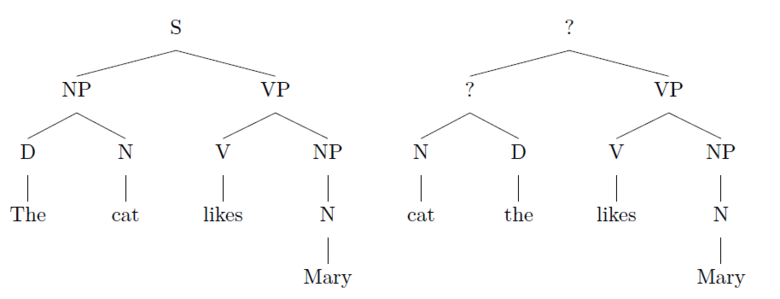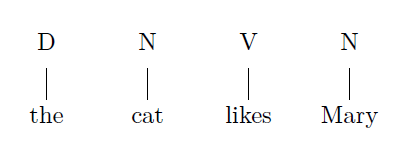Syntax 1 Wiki: Week 1: Difference between revisions
| Line 99: | Line 99: | ||
the, D <br> | the, D <br> | ||
<br> | <br> | ||
14. <b>The lexicon licences lexical local trees</b> | 14. <b>The lexicon licences lexical local trees</b><br> | ||
It is easy to see that the lexical entries contain exactly the right information | It is easy to see that the lexical entries contain exactly the right information | ||
to license the lexical local trees. The general principle is the following:<br> | to license the lexical local trees. The general principle is the following:<br> | ||
[[File:]]<br> | [[File:Lexicon.PNG]]<br> | ||
In “X<sub>L</sub>”, X is a part of speech and the subscript L means that the local tree | In “X<sub>L</sub>”, X is a part of speech and the subscript <sub>L</sub> means that the local tree is licensed by a lexical entry. | ||
is licensed by a lexical entry. | |||
Revision as of 13:12, 14 April 2019
The English Language and its Grammar
1. For the purposes of Syntactic Theory, a string consists of one or more words:
dog, Hunde, einkaufen gehen, to go shopping, the student of Linguistics,...
2. For the purposes of English Syntax, we distinguish between two kinds of strings:
- a. Strings which native speakers would accept as English: dogs, to go shopping, loves Jill, waiting for the bus, it is raining, happy cats, …
- b. Strings which native speakers would not accept as English: Hunde,einkaufen gehen, go to shopping, waiting for bus the …
3. It is the task of English syntax to explain in a precise and principled fashion
which strings of words native speakers of English accept as well formed
English and which not.
4. This task would be easy to accomplish, if one could simply list all the
English strings. But, unfortunately, one cannot do that, since there are
infinitely many well formed English strings:
| a. Mary is tired. Mary is very tired. Mary is very, very, very tired., ... |
b. Mary went to the store. Mary went to the store but Jill stayed home. Mary went to the store but Jill stayed home and Sue had the flu., ... |
5. So, it is impossible to list all and only the well formed strings of English
words. But what is possible, is to find a property that all and only the
strings of English have in common: they and only they are grammatical
according to the Grammar of English! All other strings are ungrammatical
according to the Grammar of English.
6. So, we need to concern ourselves with the Grammar of English. This is
what this course is all about!
7. For the purposes of English syntax, the Grammar of English consists
of two parts:
- a. The English Lexicon:a, aardvark, able, abut … …
- b. The English Phrase Structure Rules: S -> N(P) V(P), NP -> D N(P)…
8. With the Grammar of English at our disposal, it is now easy to define
what it means for a string of words to be grammatical English: a string
of words is grammatical English, if the English grammar licenses a
well formed phrase structure tree for that string. Otherwise, the
string is ungrammatical in English. Example:

- a. Since the tree on the left is a well formed phrase structure tree of English, its string The cat likes Mary is a grammatical expression of English.
- b. Since the tree on the right is not a well formed phrase structure tree for English, its string *cat the likes Mary is not a grammatical string of English.
9. So, we can define the English Language as all and only those strings
for which the English grammar licenses a well formed phrase structure tree.
Everything else is not part of the English language.
10. We now need to make precise how the grammar of English licenses well
formed phrase structure trees. For that, we need a simple, but important
technical concept, that of a local tree.
A local tree consists of a single mother node and 1-3 daughters:
Nothing else is a local tree.
11. We now say that the grammar of English licenses a phrase structure tree,
if that tree is completely composed of local trees and the grammar of English
licenses every one of those local trees. For example, the grammatical phrase structure tree in 8. above is composed of eight local trees.
- Four of the local trees have a word at the bottom and for that reason are called Lexical local trees:
- The other four local trees have parts of speech (= syntactic categories) as labels of all nodes and thus are called non-lexical local trees:


12. It is now easy to see how the grammar of English can license all and only
the local trees that make up all the grammatical phrase structure trees of
English. Recall that the grammar has two parts, the lexicon and the phrase
structure rules. The lexicon will license the lexical local trees of English and
the phrase structure rules will license the non-lexical local trees of English.
13. The English Lexicon revisited
We will now be a little more precise as to what the English lexicon looks like.
Here is the portion of the English lexicon that shows the words that occur in
the word strings of 8. As you can see, each word is now listed with its part
of speech:
cat, N
likes, V
Mary, N
the, D
14. The lexicon licences lexical local trees
It is easy to see that the lexical entries contain exactly the right information
to license the lexical local trees. The general principle is the following:
In “XL”, X is a part of speech and the subscript L means that the local tree is licensed by a lexical entry.
Homework for Week 2
1. Work through the following sections of the Wiki:
2. Do the Exercises on Parts of Speech.
3. Find 3 authentic examples from books or newspapers and annotate the words with their part of speech. Do this with a word processor and upload the result to Olat.
Navigation:
